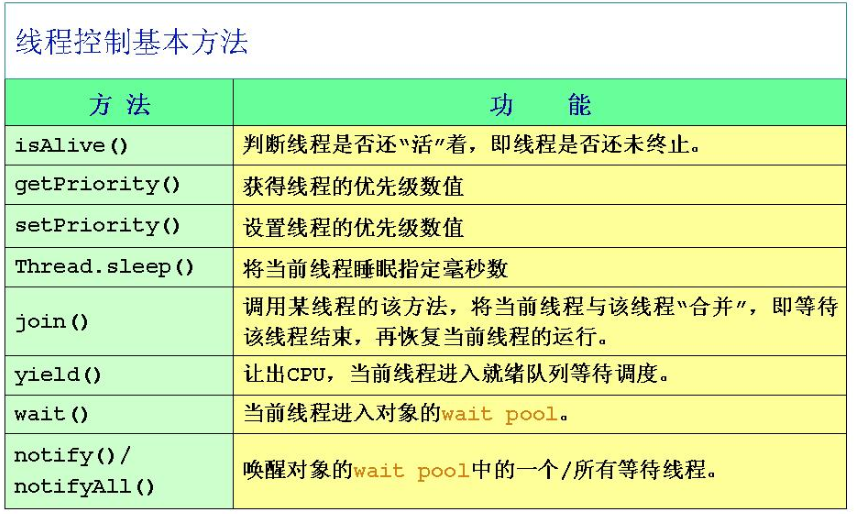基本概念
线程是一个程序内部的顺序控制流
Java的线程是通过java.lang.Thread类来实现的。main函数是一个主线程,用户可以通过创建Thread的实例来创建新的线程。每一个线程都必须实现run方法。通过Thread类的start方法来启动一个线程。
两种方式实现,一种是线程类实现Runnable接口;二种就是定义一个Thread的子类并重写其run方法。
public class TestThread1 {
public static void main(String args[]) {
Runner1 r = new Runner1();
r.start();
//r.run();
//Thread t = new Thread(r);
//t.start();
for(int i=0; i<100; i++) {
System.out.println("Main Thread:------" + i);
}
}
}
//class Runner1 implements Runnable {
class Runner1 extends Thread {
public void run() {
for(int i=0; i<100; i++) {
System.out.println("Runner1 :" + i);
}
}
}以下是几个线程控制的基本方法
用stop或者其他方法直接切断线程是很暴力的是很不好的,这里介绍一种比较好的结束线程的办法。巧妙的用到一个flag。
public class TestThread4 {
public static void main(String args[]){
Runner4 r = new Runner4();
Thread t = new Thread(r);
t.start();
for(int i=0;i<100000;i++){
if(i%10000==0 & i>0)
System.out.println("in thread main i=" + i);
}
System.out.println("Thread main is over");
r.shutDown();
//t.stop();
}
}
class Runner4 implements Runnable {
private boolean flag=true;
public void run() {
int i = 0;
while (flag==true) {
System.out.print(" " + i++);
}
}
public void shutDown() {
flag = false;
}
}线程同步
线程同步这个问题很重要,会衍生很多锁的问题。也是两种方式上锁,一种是直接在方法上上锁,另一种就是锁对象。
public class TestSync implements Runnable {
Timer timer = new Timer();
public static void main(String[] args) {
TestSync test = new TestSync();
Thread t1 = new Thread(test);
Thread t2 = new Thread(test);
t1.setName("t1");
t2.setName("t2");
t1.start();
t2.start();
}
public void run(){
timer.add(Thread.currentThread().getName());
}
}
class Timer{
private static int num = 0;
public synchronized void add(String name){
//synchronized (this) {
num ++;
try {Thread.sleep(1);}
catch (InterruptedException e) {}
System.out.println(name+", 你是第"+num+"个使用timer的线程");
//}
}
}死锁
假如两个线程都需要两个资源才能完成,A线程把a资源锁定等待b资源,B线程把b资源锁定等待a资源。这样就会形成死锁,所以我们要把锁定义到最大化就是锁定整个对象,就是专业术语说锁的粒度要尽量大。
public class TT implements Runnable {
int b = 100;
public synchronized void m1() throws Exception{
//Thread.sleep(2000);
b = 1000;
Thread.sleep(5000);
System.out.println("b = " + b);
}
public void m2() throws Exception{
Thread.sleep(2500);
b = 2000;
}
public void run() {
try {
m1();
} catch(Exception e) {
e.printStackTrace();
}
}
public static void main(String[] args) throws Exception {
TT tt = new TT();
Thread t = new Thread(tt);
t.start();
tt.m2();
System.out.println(tt.b);
}
}这个程序段输出的结果是
2000
b = 2000
这段程序也是先进的m2。
package yanning;
public class TT implements Runnable {
int b = 100;
public synchronized void m1() throws Exception{
System.out.println(2);
//Thread.sleep(2000);
b = 1000;
Thread.sleep(5000);
System.out.println("b = " + b);
}
public synchronized void m2() throws Exception {
System.out.println(1);
Thread.sleep(2500);
b = 2000;
}
public void run() {
try {
m1();
} catch(Exception e) {
e.printStackTrace();
}
}
public static void main(String[] args) throws Exception {
TT tt = new TT();
Thread t = new Thread(tt);
t.start();
tt.m2();
System.out.println(tt.b);
}
}这段代码输出的结果是
1
2000
2
b = 1000
package yanning;
public class TT implements Runnable {
int b = 100;
public synchronized void m1() throws Exception{
//System.out.println(2);
//Thread.sleep(2000);
b = 1000;
Thread.sleep(5000);
System.out.println("b = " + b);
}
public synchronized void m2() throws Exception {
//System.out.println(1);
Thread.sleep(2500);
b = 2000;
}
public void run() {
try {
m1();
} catch(Exception e) {
e.printStackTrace();
}
}
public static void main(String[] args) throws Exception {
TT tt = new TT();
Thread t = new Thread(tt);
t.start();
tt.m2();
System.out.println(tt.b);
}
}这一段代码执行结果是
1000
b = 1000
锁是锁住了,但是tt那个线程执行的快一些,先进入了m2。
所以说线程同步是一个很复杂的问题,我们得仔细推敲。而且我个人觉得跟电脑的运行速度还是有关系的。其他线程可以自由访问没有加同步的任何方法,并且会产生数据不一致的现象。如果要保护好某一类的同步对象,必须要对该对象所有的方法考虑加不加同步,加了同步很有可能效率会变低,不加同步很有可能造成数据不一致的现象。
优先级
我的理解就是CPU优先让哪个线程执行嘛,比较单CPU其实是假的多线程,就是因为CPU运算速度比较快,所以就一个线程让你执行一下,就像是多线程在执行一样。
生产者与消费者问题【经典问题】
public class ProducerConsumer {
public static void main(String[] args) {
SyncStack ss = new SyncStack();
Producer p = new Producer(ss);
Consumer c = new Consumer(ss);
new Thread(p).start();
new Thread(c).start();
}
}
class WoTou {
int id;
WoTou(int id) {
this.id = id;
}
public String toString() {
return "WoTou : " + id;
}
}
class SyncStack {
int index = 0;
WoTou[] arrWT = new WoTou[6];
public synchronized void push(WoTou wt) {
while(index == arrWT.length) {
try {
this.wait();
} catch (InterruptedException e) {
e.printStackTrace();
}
}
this.notifyAll();
arrWT[index] = wt;
index ++;
}
public synchronized WoTou pop() {
while(index == 0) {
try {
this.wait();
} catch (InterruptedException e) {
e.printStackTrace();
}
}
this.notifyAll();
index--;
return arrWT[index];
}
}
class Producer implements Runnable {
SyncStack ss = null;
Producer(SyncStack ss) {
this.ss = ss;
}
public void run() {
for(int i=0; i<20; i++) {
WoTou wt = new WoTou(i);
ss.push(wt);
System.out.println("生产了:" + wt);
try {
Thread.sleep((int)(Math.random() * 200));
} catch (InterruptedException e) {
e.printStackTrace();
}
}
}
}
class Consumer implements Runnable {
SyncStack ss = null;
Consumer(SyncStack ss) {
this.ss = ss;
}
public void run() {
for(int i=0; i<20; i++) {
WoTou wt = ss.pop();
System.out.println("消费了: " + wt);
try {
Thread.sleep((int)(Math.random() * 1000));
} catch (InterruptedException e) {
e.printStackTrace();
}
}
}
}






















 933
933

 被折叠的 条评论
为什么被折叠?
被折叠的 条评论
为什么被折叠?








